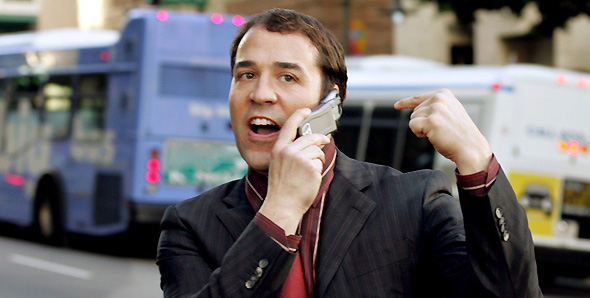Get Things Done Like a Boss

Are you reading this article with 27 browser tabs open? Have you checked your inbox three times in the last minute to see if you have any new email?
STOP IT. Try focusing on this one thing, and just read this article. The difference will amaze you.
In our last editorial meeting—where the Juicy team brainstorms the content we want to produce for this blog and newsletter—the team mentioned how difficult it is to manage your time working online with social media, client interruptions and fast moving deadlines. I couldn’t agree more. When you work in front of a computer, and in an office full of people, distractions are everywhere!
As leader of our growing enterprise, my biggest challenge is making sure that I am moving the company forward, while putting out fires and maintaining our client work along the way (all while making sure we don’t run out of coffee or office supplies). If I don’t set a course and make sure we’re sticking to a plan, who will? No one appreciates the importance of time management and prioritization more than me around here, so I naturally volunteered some thoughts on the issue.
About 8 years ago, I found a blog post by Marc Andreessen proclaiming his love for productivity porn. With a name like that, who couldn’t read further?! I was hooked—and since then I’ve developed an addiction to anything that will give me an edge, or allow me to accomplish more than is humanly possible in a lifetime (or at least make me think I can).
I’m far from perfect when it comes to time management and focus, but I’d like to share some concepts and tips that allow me to “get things done like a boss” as the team puts it.
There are some simple quick tips at the bottom, but first I’m going to share some key concepts that have changed the way I look at productivity. They’re like proverbs: they take only a moment to read, but you can spend a lifetime understanding them and perfecting them.
Without an understanding of these concepts, the tips are disconnected and can be misinterpreted.
Productivity Concepts
Sub conscious planning and problem solving
Study after study shows that your mind works on problems and repeats tasks subconsciously. One experiment showed that participants improved dramatically on simple paperwork tasks days after only learning them and doing the exercises once. How could this be? Their mind was practicing them subconsciously! You’ve probably also discovered the perfect answer to a problem after walking away after spending hours on it. This is your incredible subconscious mind at work.
 Use this biological tool to your advantage by writing down your most pressing and time consuming challenges. Review them each day and I guarantee the answers will come to you without the need to discuss it or over-research it. Additionally, I like to review the most important items that I plan to do the next day before I go home. This allows me to mentally (subconsciously and consciously) prepare for these tasks while sleeping, showering and on the way into work without being stressed about them. The inspiration and effectiveness I find when doing this versus the days I don’t is quite noticeable.
Use this biological tool to your advantage by writing down your most pressing and time consuming challenges. Review them each day and I guarantee the answers will come to you without the need to discuss it or over-research it. Additionally, I like to review the most important items that I plan to do the next day before I go home. This allows me to mentally (subconsciously and consciously) prepare for these tasks while sleeping, showering and on the way into work without being stressed about them. The inspiration and effectiveness I find when doing this versus the days I don’t is quite noticeable.
Daily Prioritization (on paper)
The oldest organization trick in the book is making a to do list. And like many, I have been addicted to the Getting Things Done method for years. But, anyone who’s ever made a to-do list knows the frustration of seeing the list longer at the end of the day than when you started. A perpetual list of things “to do” can leave you with a sense of defeat and overwhelm.
 Recently, I learned a slight, but powerful new twist on my daily to-do list. I actually estimate how long each task will take me (5 mins, 30 mins, an hour) and then I use this as a reality check to make sure I am being realistic about my day. Almost immediately, I realized I had been way too ambitious with what I could get done each day. I schedule 80% of my day with this list. If you work with other people, surprises are sure to come up. Leaving some slack will make sure you get the important things done. Learn to identify what is important, and protect the time to do that work.
Recently, I learned a slight, but powerful new twist on my daily to-do list. I actually estimate how long each task will take me (5 mins, 30 mins, an hour) and then I use this as a reality check to make sure I am being realistic about my day. Almost immediately, I realized I had been way too ambitious with what I could get done each day. I schedule 80% of my day with this list. If you work with other people, surprises are sure to come up. Leaving some slack will make sure you get the important things done. Learn to identify what is important, and protect the time to do that work.
You have to get the most important things (not to be confused with the urgent things) on paper and staring at you in the face. As the saying goes: The worst place to think is inside your head. Inevitably, there will be one big task on there that will have a positive impact on your future, and it’s probably the hardest one to do. Do it first.
When you eat the crust first, the rest of your day is pie. And remember, at the end of the day, plan tomorrow.
Begin with the end in mind
 I discovered this one over a decade ago when reading Steven Covey’s classic, “7 Habits of Highly Successful People” and it just keeps showing up in new things that I learn. I apply this to everything—from the tiniest of tasks, to my biggest initiatives. Just ask yourself “what do I want to get out of this meeting?” or “how will I know when this task is complete?” or “where do I want to be next year with this initiative?” This requires vision, which I believe is a skill that can be improved with practice. The most effective people I have ever worked with have had one thing in common: clear vision.
I discovered this one over a decade ago when reading Steven Covey’s classic, “7 Habits of Highly Successful People” and it just keeps showing up in new things that I learn. I apply this to everything—from the tiniest of tasks, to my biggest initiatives. Just ask yourself “what do I want to get out of this meeting?” or “how will I know when this task is complete?” or “where do I want to be next year with this initiative?” This requires vision, which I believe is a skill that can be improved with practice. The most effective people I have ever worked with have had one thing in common: clear vision.
Beginning with the end in mind will help you stay focused on why you are doing what you are doing and will get you to the outcome much faster.
Awareness and focus
Have you ever had to get something done before a hard deadline that normally takes you three times as long, but somehow you focus and knock the task out with ease? I would bet that the average person gives what their doing ⅓ or less of their total mental energy. I can tell you from lots of experience, if you concentrate (I mean, really concentrate) on what you’re doing, things will be different. Removing distractions (see the tip below about clean spaces) and you will be surprised by how quickly you can accomplish seemingly big tasks—and by the increased quality of the output.
Think about that: get better work done in less time so that you can do the other things you want in life. Why wouldn’t you dedicate your focus and awareness to every task?
With those concepts in mind, here are some tips that can help you maximize your day.
Productivity Tips
Timer
 I use a desktop widget to manage short bursts of productivity. If I think it will take me an hour to come up with a project plan, I’ll set the timer for 15 mins to focus on identifying all tasks, then use the timer again for another 30 minute burst of organizing and scheduling that list. This little timer, paired with chunking large tasks down into smaller tasks, is perfect for making sure you are making real progress.
I use a desktop widget to manage short bursts of productivity. If I think it will take me an hour to come up with a project plan, I’ll set the timer for 15 mins to focus on identifying all tasks, then use the timer again for another 30 minute burst of organizing and scheduling that list. This little timer, paired with chunking large tasks down into smaller tasks, is perfect for making sure you are making real progress.
Clean spaces
Free your workspace from distractions. This includes your physical desktop, computer screen and especially browser tabs. Use one browser window per project, and only have the tabs open you need for what you are working on. Close your inbox and social media sites when you don’t need them for what you are working on. Simple, but effective.
Touch it once: Do it, Delegate it, Dump it, or Defer it
With every email and anything that comes across your desk, remember to use one of the four “D’s.” Business coach Juan Ortega gave me this phrase to outline the only actions you can possibly take on any task that you encounter. Make a decision the first time you touch it and avoid the trap of seeing something and “thinking” you took care of it.
And remember, don’t be afraid to throw it away (or delete it). What’s the worse that can happen?
Evacuate your inbox
This should be easy if you are following the tip above. The number one time suck for me is an overflowing inbox of things I need to eventually get too. I process all email that has been “handled” into client folders (or the trash), and queue up all open emails into folders based on when I can handle them. Leave every day with an empty inbox and your procrastination will melt away.
Manage your energy, not just your time
 When focusing on what needs to get done, most people view all tasks equally in terms of energy required. It takes far less energy to send an invoice or make a phone call than it does to craft a creative brief for an advertising campaign. If you take stock of how much energy various tasks require from you, you can learn to schedule them at the right time. For example, I am full of creative energy—and caffeine—early in the day. I’ve learned that even if I have three working hours left in the day, I may not have the energy to get something very creative or intense done well. However, I can return calls all afternoon and enjoy it. Understand your energy levels and schedule your day to coincide with them.
When focusing on what needs to get done, most people view all tasks equally in terms of energy required. It takes far less energy to send an invoice or make a phone call than it does to craft a creative brief for an advertising campaign. If you take stock of how much energy various tasks require from you, you can learn to schedule them at the right time. For example, I am full of creative energy—and caffeine—early in the day. I’ve learned that even if I have three working hours left in the day, I may not have the energy to get something very creative or intense done well. However, I can return calls all afternoon and enjoy it. Understand your energy levels and schedule your day to coincide with them.
Don’t open email (or Facebook) first thing in the morning
It is so tempting, almost natural, to want to check in on the world before you begin working. But, this one little sin changes your mindset from proactive to reactive in an instant. This is especially hard when working on the West Coast, because you feel your East Coast colleagues and clients are online and waiting for you. Make sure that you’ve accomplished your most important item for the day before opening your email.
Start (really) early
Top performers seem to all have a quirky little trait… we love to wake up crazy early! Peter Shankman does a great job of making the case for how waking up early will have a positive effect on your productivity.
Did I miss any critical tips or concepts? Feel free to add your own below.








Angela Kreye-Shockey
May 22, 2013 at 3:50 pm
Jeremy, these are really great insights. Don’t check email first thing? I don’t know if I can do it, but I can try!
Ann Shea
May 23, 2013 at 3:21 pm
Super tips. It’s an honor to work with someone who actually walks the talk and can model these for us. Lots of good tips and techniques here. And I’m glad you’re recommending to eat the crust first, and then the pie, rather than eating the frog, as some will advise!
Susan Joslyn
May 29, 2013 at 1:06 pm
For many of us in the service/customer facing side of the business, checking our email *is* the most important task of the day. But you are right, I tend to check in on my work email, my personal email and Facebook as I’m waking up in the morning and slugging down coffee. I’ll try not doing the personal side until later and see how it affects my productivity! Good stuff, thanks!
Mara Shorr
May 29, 2013 at 1:23 pm
Love this blog post! Working hard to stick to a TO DO list instead of jumping every time an email comes in. But it’s definitely not easy!
Frank B
May 30, 2013 at 8:38 am
And to think I almost didn’t have time to read this article. Glad I did, a lot of good stuff in here. Thanks.
Ryan
June 11, 2013 at 2:37 pm
Thank you for the insights! Especially the mention for West Coast based businesses.
Ryan
June 11, 2013 at 2:39 pm
Quick follow up question, do you ever use an App for To-Do’s? Wunderlist for example…
Nicole YSS
July 11, 2013 at 4:49 am
Good write up. Thanks 🙂
Angela Kreye-Shockey
February 20, 2015 at 10:45 am
We love seeing such a great response to our posts!